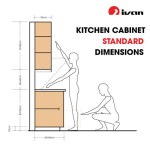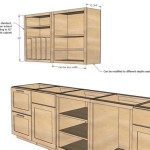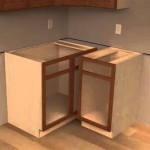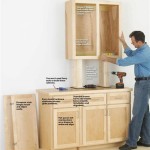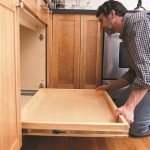CNC Plywood Kitchen Cabinets: Precision and Practicality
Kitchen renovations and new builds frequently involve selecting cabinetry that balances aesthetic appeal, durability, and cost-effectiveness. CNC plywood kitchen cabinets have emerged as a popular choice due to their precision manufacturing, material advantages, and design flexibility. This article explores the characteristics, benefits, construction, and considerations associated with incorporating CNC plywood cabinets into a kitchen design.
The acronym CNC stands for Computer Numerical Control. In the context of woodworking and cabinet making, CNC technology utilizes computer-controlled machinery to precisely cut and shape materials according to pre-programmed designs. This automated process allows for intricate detailing, consistent accuracy, and efficient production, leading to cabinets with tight tolerances and smooth finishes.
Understanding Plywood as a Cabinet Material
Plywood is an engineered wood product constructed from multiple layers of thin wood veneers, called plies, that are bonded together with adhesive. These plies are arranged with their grain running in alternating directions, a process known as cross-graining. This cross-graining significantly enhances the plywood's strength and stability, making it resistant to warping, cracking, and shrinking compared to solid wood counterparts.
Different types of plywood are available, each with varying grades and compositions. For kitchen cabinets, cabinet-grade plywood is typically preferred. This type of plywood uses higher-quality veneers and adhesives, resulting in a more durable and aesthetically pleasing product. Furthermore, different wood species such as birch, maple, and oak are commonly used for the face veneers, allowing for diverse aesthetic options for the cabinet exteriors. The core material can also vary. For example, marine-grade plywood is exceptionally water-resistant due to the adhesive used and is suitable for areas with high humidity or potential water exposure, although generally not necessary for standard kitchen applications.
The thickness of plywood used in cabinet construction varies depending on the specific application. Typically, thicker plywood is used for cabinet boxes and load-bearing components, while thinner plywood may be used for backs or decorative panels. Industry standards provide guidelines for plywood thickness based on structural requirements and cabinet dimensions.
The Advantages of CNC Manufacturing for Plywood Cabinets
CNC manufacturing offers several significant advantages over traditional cabinet-making methods. These benefits stem from the automated precision and consistency inherent in the CNC process.
First, CNC machines provide exceptional accuracy in cutting and shaping plywood panels. This precision ensures that cabinet components fit together seamlessly, resulting in strong and visually appealing joints. The tight tolerances achieved through CNC machining minimize gaps and inconsistencies, contributing to the overall quality and durability of the finished cabinets.
Second, CNC technology allows for intricate designs and complex shapes to be incorporated into cabinet designs. Custom profiles, decorative carvings, and unique hardware mounting positions can be precisely executed with CNC machines. This design flexibility empowers homeowners and designers to create customized kitchen environments that reflect their specific needs and aesthetic preferences.
Third, CNC manufacturing significantly reduces material waste. The computer-controlled cutting process optimizes material usage, minimizing scrap and maximizing the yield from each plywood sheet. This waste reduction contributes to cost savings and promotes environmentally responsible manufacturing practices.
Fourth, CNC automation streamlines the cabinet production process. The automated nature of CNC machining reduces the need for manual labor, accelerating production times and improving overall efficiency. This faster turnaround allows for quicker installation and minimizes disruption to the home renovation process.
Fifth, CNC manufacturing ensures consistency across multiple cabinet units. Every cabinet component is cut and shaped according to the same pre-programmed instructions, resulting in uniform dimensions and consistent quality. This consistency is particularly important for large kitchen installations where uniform spacing and alignment are critical for a cohesive and aesthetically pleasing design.
Key Considerations When Choosing CNC Plywood Kitchen Cabinets
Selecting CNC plywood kitchen cabinets involves careful consideration of several factors to ensure that the chosen cabinets meet the specific needs and aesthetic preferences of the homeowner.
One crucial consideration is the grade and quality of the plywood used in cabinet construction. As mentioned earlier, cabinet-grade plywood is recommended for kitchen cabinets due to its enhanced durability and appearance. It is important to inquire about the specific grade and species of plywood used by the cabinet manufacturer to ensure that it meets the desired quality standards.
Another important consideration is the type of finish applied to the plywood cabinets. Various finishing options are available, including stains, paints, and clear coats. The choice of finish will impact the cabinet's appearance, durability, and resistance to moisture and stains. It’s important to choose a finish that complements the overall kitchen design and provides adequate protection against daily wear and tear.
Hardware selection also plays a crucial role in the functionality and aesthetics of CNC plywood kitchen cabinets. High-quality hinges, drawer slides, and knobs can significantly enhance the cabinet's ease of use and overall longevity. It is important to choose hardware that is durable, reliable, and aesthetically compatible with the cabinet design.
The installation process is also a critical factor in the success of CNC plywood kitchen cabinets. Proper installation ensures that the cabinets are level, plumb, and securely fastened to the walls. Professional installation is highly recommended to avoid potential problems such as uneven gaps, misaligned doors, and unstable cabinets.
Finally, budget considerations are essential when selecting CNC plywood kitchen cabinets. The cost of CNC plywood cabinets can vary depending on the grade of plywood, the complexity of the design, the type of finish, and the hardware selected. It's important to obtain quotes from multiple cabinet manufacturers and compare pricing to ensure that the chosen cabinets fit within the allocated budget.
The selection of edging also warrants consideration. Plywood edges can be exposed or covered with edge banding. Edge banding, typically made of wood veneer, PVC, or ABS, provides a finished look, protects the plywood edge from moisture, and enhances durability. The choice of edge banding material and its application method influences the cabinet's overall aesthetics and longevity.
When planning the cabinet layout, understanding the limitations and possibilities of CNC manufacturing is beneficial. While CNC machines can create intricate designs, certain complex shapes or deep carvings might require specialized tooling or multiple machining passes, potentially impacting cost and production time. Communicating design requirements clearly with the cabinet manufacturer is essential to ensure feasibility and cost-effectiveness.
Comparing CNC Plywood Cabinets to Other Options
It's essential to compare CNC plywood cabinets to other cabinet material options, such as solid wood, particleboard, and MDF (Medium-Density Fiberboard), to make an informed decision. Solid wood cabinets offer a classic aesthetic and are generally considered to be highly durable, but they can be more expensive and susceptible to warping and cracking. Particleboard cabinets are a more affordable option, but they are less durable and resistant to moisture than plywood.
MDF cabinets offer a smooth, consistent surface that is ideal for painting, but can be more susceptible to damage from moisture than plywood. CNC plywood cabinets offer a balance of durability, affordability, and design flexibility, making them a suitable option for many kitchen renovation projects.
Compared to solid wood, CNC plywood cabinets provide superior stability due to the cross-grained construction, minimizing warping and cracking. This stability is particularly advantageous in kitchens where temperature and humidity fluctuations are common. While solid wood may offer a more traditional aesthetic, CNC plywood cabinets can be finished to mimic the look of solid wood, offering a similar visual appeal at a potentially lower cost.

How To Make Cabinet Doors With Cnc Machines

Plywood Kitchen Ideas Grand Designs

Birkwood Innovative Cabinet Makers Scotland

Plyology Kitchens Birch Plywood Kitchen Cabinets And Doors

High Quality Birch Plywood Kitchen Base Units Order

How To Make Kitchen Cabinet Doors With Cnc Router Igolden

Are Kitchen Cabinets Er To Build Or Buy Cnc Crafted Work

Cnc Router For Cabinet Making Maker Tekcel Machinery

How To Choose The Right Kitchen Cabinet Materials For Your Project Architizer Journal

Remodeling Kitchen Cabinets With A Cnc Router
Related Posts



